2017
January 12 - March 4: Shelley Niro: Battlefields of my Ancestors & Cold Front
Shelley Niro: Battlefields of my Ancestors
January 12 - March 4, 2017
Opening Reception: Thursday, January 12, 2017 at 7:00 PM
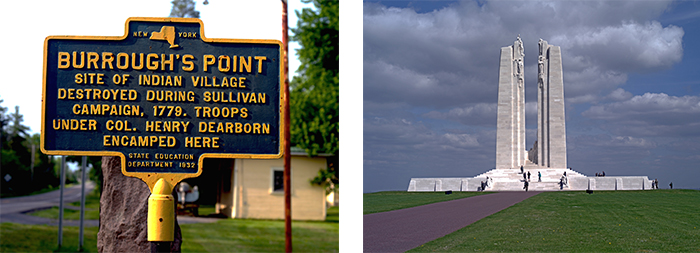
Image: Shelley Niro, Battlefields of my Ancestors 2010 (detail), image courtesy of the artist.
In this exhibition, artist Shelley Niro (Mohawk, turtle clan) explores historic battlefields that hold significance for her people. Beginning in New York State, where she was born, Niro documents the location of Cayuga villages destroyed during the American Revolutionary War and follows the subsequent migration to the area now known as the Six Nations near Brantford, Ontario. The final image depicts the Canadian memorial at Vimy Ridge. In addition to Canada’s sesquicentennial, 2017 also marks the 100 th anniversary of the Battle of Vimy Ridge, which is often understood as a key event in the development of our national identity as a sovereign country.
About one third of Indigenous men in Canada age 18 to 45 enlisted during the First World War. Hundreds were wounded and over 300 died on foreign battlefields. At least 50 were awarded medals for bravery and heroism. Aboriginal women were active on the home front, contributing to the war effort through fundraising and other means. After the war, Indigenous veterans, who did not receive the same benefits as others who served, began to organize politically. In 1919, Six Nations Lieutenant F.O. Loft founded the first national pan-Indian political organization: the League of Indians of Canada. According to Niro: “Vimy Ridge was an important place because that’s where all the nations came together and went as one nation to another place to fight this battle. There are quite a few men from Six Nations that died at Vimy.”[i]
This exhibition also includes a major work by Niro from the McIntosh Gallery collection that elides the histories of the First World War and that of the Indigenous people of Eastern North America, through the stories of two heroic women. In Parallel Worlds of Women and Warriors, 2010, Niro begins with a stereoscopic image and text about Mlle Semmer, a French woman who was “Decorated for Heroic Actions under Fire” during the First World War. Niro describes how this French photograph, which she found in an antique store, “made her realize that we don’t often see Indigenous people, especially women, “placed in the context of heroes”. Using the format of a double image with an explanatory text identical to that of the Mlle Semmer stereoscope, Niro casts the story of Jigosase, a heroine widely recognized in Indigenous culture and referred to as “the Mother of All Nations”, to convey her own Haudenosaunee history. Niro links the found and the fictive stereoscopic views with a central image of Two Row Wampum, a treaty woven from beads that directed two different cultures to live in harmony. As Niro puts it: “The philosophy is that two cultures can live together if they remain parallel, never putting their foot into the other culture or canoe.” Typically geometric, Niro digitally-altered the Wampum image into a stunning, undulating flower-like composition.
Internationally acclaimed as an artist and filmmaker, Niro was born in Niagara Falls, New York in 1954 and grew up on the Six Nations Reserve, near Brantford, Ontario. Shelley received her MFA from Western University’s Department of Visual Arts in 1997. She was the first recipient of the Ontario Arts Council’s Aboriginal Art Award in 2012. Her work is represented in many public art collections including the National Gallery of Canada and the Art Gallery of Ontario. Her work has been exhibited extensively in Canada and internationally. She is most noted for her photographs using herself and female family members cast in contemporary positions to challenge the stereotypes and clichés of Native American women. Her short film, The Shirt, was presented at the 2003 Venice Biennale and the 2004 Sundance Film Festival in Park City, Utah.
Acknowledgements
Shelley Niro: Battlefields of my Ancestors is part of Western’s Canada 150 programming in celebration of Canada’s sesquicentennial. Western’s Canada 150 committee comprises staff, faculty and students and is co-chaired by Professor Jerry White, Department of Sociology, and Marcia Steyaert, Communications & Public Affairs. McIntosh Gallery gratefully acknowledges the financial support of Western’s Canada 150 Committee, which has made this exhibition and related programs possible.
Western University is situated on the traditional territories of the Anishinaabeg, Haudenosaunee, Lunaapeewak and Attawandaron peoples who have longstanding relationships to the land and region of southwestern Ontario and the City of London.
The local First Nation communities of this area include Chippewas of the Thames First Nation, Oneida Nation of the Thames, and Munsee Delaware Nation. In the region, there are eleven First Nation communities and a growing Indigenous urban population. Western values the significant historical and contemporary contributions of local and regional First Nations and all of the Original peoples of Turtle Island (North America).

Related Programs:
Exhibition opening reception with artist in attendance
Thursday, January 12 th at 7:00 PM
Evan J. Habkirk lecture entitled "Battlefields: Physical and Political Struggles of the Haudenosaunee"
Thursday, January 19 th at 12:30 PM at McIntosh Gallery
Curator-led tour with James Patten
Friday, February 3 rd at 12:30 PM
Shelley Niro artist talk
Thursday, February 16 th at 7:00 PM
North Campus Building, room NC 113, free admission. Presented in collaboration with Western University’s Department of Visual Arts, as part of its ArtNow Winter 2017 Speakers' Series, organized by Christof Migone.
Please contact Mitra Shreeram mshreera@uwo.ca for more information.
[i] Brant News, October 7, 2015
Cold Front
January 12 – March 4, 2017
Opening Reception: Thursday, January 12, 2017 at 7:00 PM
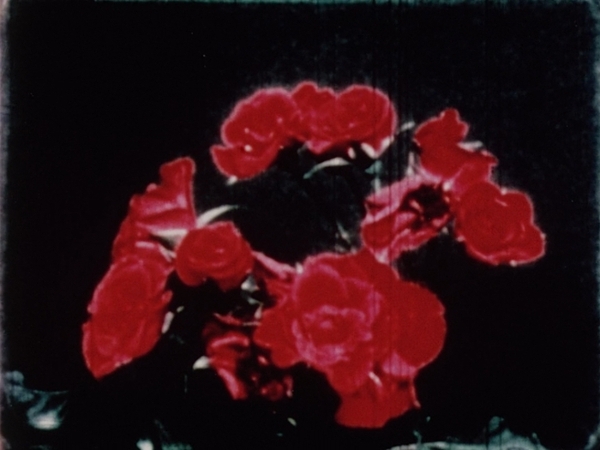
Image: Jack Chambers, Hybrid (still from film) , 1966, image courtesy of the Canadian Filmmakers Distribution Centre.
This exhibition features six artists –Tom Benner, John Boyle, Jack Chambers, Greg Curnoe, Jamelie Hassan, and Tony Urquhart – who worked in London, Ontario during the Cold War (1947-91). In this period of heightened political tension, capitalist and communist countries battled to shape global economic development and modernization according to their respective ideals.
Cold Front looks at the varied ways in which these regional artists navigated the anxieties of the international Cold War. In the lithograph America, May 31, 1989–June 30, 1989, 1989, Greg Curnoe takes a satirical approach to Yankee imperialism by asking the viewer to consider a map of North America in which the United States has been removed, leaving only Canada and Mexico.
In what is arguably his most overtly political film, Jack Chambers’ Hybrid, 1966, contrasts images of flowers from a found horticultural film and footage from the Vietnam War.
Tony Urquhart painted Calm, 1962, at McIntosh Gallery while artist-in-residence just before the Cuban Missile Crisis. Though apparently static–the calm before the storm–a massive brown cloud suggests the slow-rolling motion of a nuclear explosion. Urquhart conveys a veil of uncertainty symbolic of the ominous atmosphere of the 1960s.
Cold Front is guest curated by art history graduate students in the Department of Visual Arts: Beatriz Asfora, Brad Morosan, Kelsey Perreault, Caroline Rabideau, Mackenzie Sinclair, and Ruth Skinner, with Professor Sarah Bassnett and McIntosh Gallery Curator Catherine Elliot Shaw.
Acknowledgements
Cold Front is part of Western’s Canada 150 programming in celebration of Canada’s sesquicentennial. Western’s Canada 150 committee comprises staff, faculty and students and is co-chaired by Professor Jerry White, Department of Sociology, and Marcia Steyaert, Communications & Public Affairs. McIntosh Gallery gratefully acknowledges the financial support of Western’s Canada 150 Committee, which has made this exhibition and related programs possible.

Related Programs
Opening Reception with curators and exhibiting artists in attendance
Thursday, January 12th, at 7:00 PM
Curator-led exhibition tour with Kelsey Perreault
Friday, January 27th at 12:30 PM
Please contact Mitra Shreeram at mshreera@uwo.ca for more information.
The John and Suzanne Kaufmann Collection of African Art
D.B. Weldon Library Display Cases, First Floor
February 6 to February 28, 2017
In celebration of Black History Month 2017, McIntosh Gallery is pleased to present selections from The John and Suzanne Kaufmann Collection of African Art.
Curated by Temi Olasehinde, works are selected from an array of over 200 nineteenth and twentieth century pieces. This installation includes tribal masks, ancestral figures, jewellery, sculpture and textiles made by artists from over thirty ethnic groups including the Dan, Mossi, Asante, Luluwa and Dogon peoples.
Since the mid-twentieth century, the late John and Suzanne Kaufmann maintained a keen interest in collecting fine examples of art that celebrated the diversity of African visual culture, an interest handed down from Suzanne’s family who began collecting in the early part of the 20 th century.
For more information, contact Mitra Shreeram at mshreera@uwo.ca for more information.
March 23 - June 25: In the Beginning, 1942 & Behind the Lines: Canada's Home Front During the First and Second World Wars
In the Beginning, 1942
March 23 to June 25, 2017
Opening Reception: March 23 at 7 PM
Extended Hours: Sunday June 25, 12 PM - 4 PM
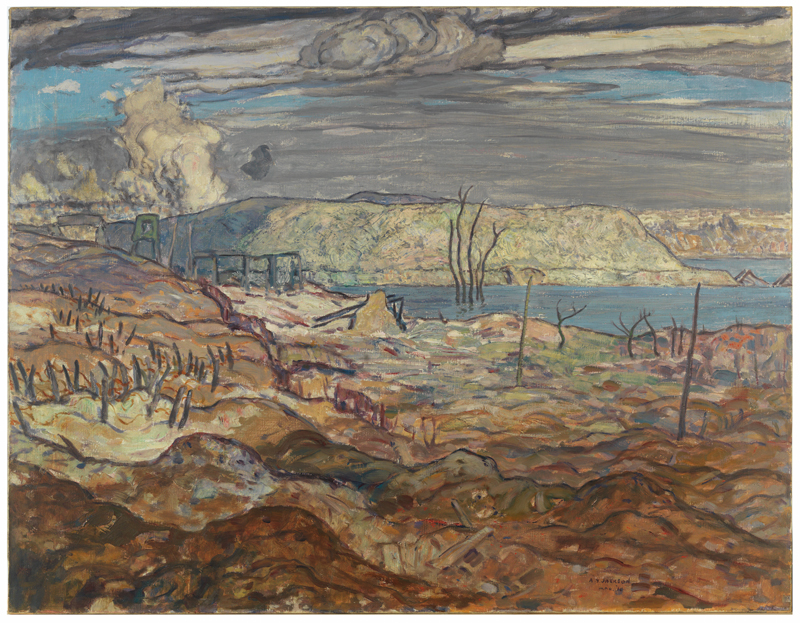
Image: Alexander Young Jackson, The Green Crassier, 1918, 1918. Oil on canvas, 86.7 x 112.0 cm, CWM 19710261-0183
This year, McIntosh Gallery celebrates its 75 th anniversary as the oldest university art gallery in Ontario. In 1942 the opening exhibition presented thirty paintings commissioned by the Canadian War Memorials Fund during the First World War as a unique record of Canadian achievements and war heroes. In the Beginning, 1942 reunites these paintings, now housed at the Canadian War Museum, for the first time in 75 years. Works by future Group of Seven artists A.Y. Jackson, Arthur Lismer, and Frederick Varley will join those of fellow Canadians Maurice Galbraith Cullen and John William Beatty, British artist Algernon Mayow Talmage, and Australian James Peter Quinn. The remaining twenty-three images will be represented digitally.
McIntosh Gallery gratefully acknowledges the assistance of the Canadian War Museum in loaning 27 key works to both exhibitions.
About McIntosh Gallery:
McIntosh Gallery, located at the heart of Western University, is the result of a generous bequest by Wilhelmina Morris McIntosh which included funds to build a gallery and her personal art collection. Despite wartime limitations on construction, the building was officially opened on June 26, 1942 with an address by established Canadian artist Charles Comfort. Today, McIntosh Gallery is a centre for the production, exhibition, interpretation and collection of visual culture. The collection has grown to over 4,000 art objects by primarily Canadian artists, many of whom are local to London.
About the Canadian War Memorials Fund:
Beaverbrook established the Canadian War Memorials Fund in 1916 to commission official war artists to paint the Canadian war effort. The official war art program would eventually employ close to 120 artists, most of them British or Canadian, who created nearly 1,000 works of art. While most of the works depicted the fighting forces and geography overseas, important artists like Mabel May and Manly MacDonald painted women in Canadian factories and fields.
Behind the Lines: Canada's Home Front During the First and Second World Wars
March 23 to June 25, 2017
Opening Reception: March 23 at 7 PM
Extended Hours: Sunday June 25, 12 PM - 4 PM
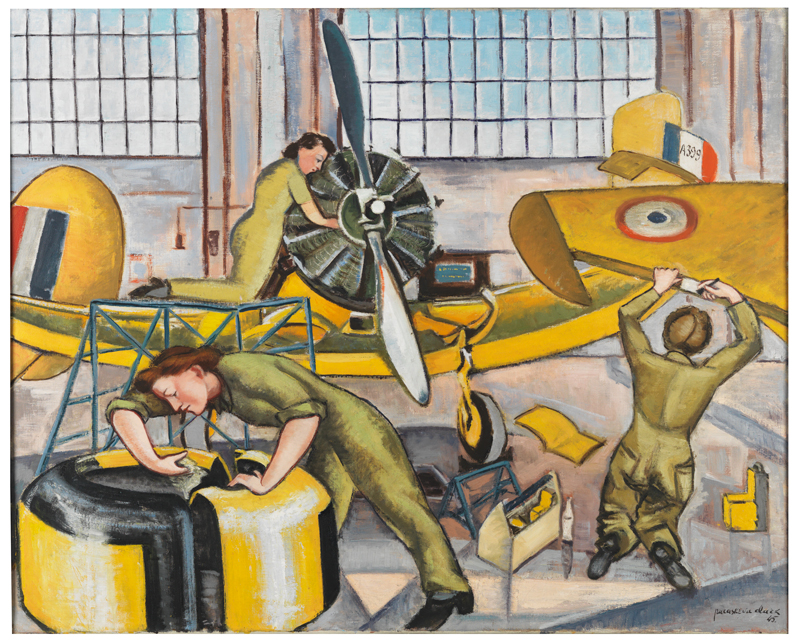
Paraskeva Clark, Maintenance Jobs in the Hangar, 1945. Oil on canvas, 81.5 x 101.9 cm, CWM 19710261-5678
Behind the Lines provides a glimpse into the personal sacrifice and hard work of determined Canadians at home who collectively supported the armed forces overseas during two world conflicts. Assembled from public and private collections across Canada, the artworks tell the stories of ordinary men and women who wielded tools, searched for submarines, worked the land, and guarded prisoners. Through them we witness unprecedented developments in manufacturing, travel, and social upheavals such as the changing roles of women entering the workplace and armed forces.
McIntosh Gallery gratefully acknowledges the assistance of the Canadian War Museum in loaning 27 key works to both exhibitions.
Temporary Display of Artifacts
As part of its 75th anniversary exhibitions, McIntosh Gallery is hosting a series of mini-displays featuring war-related artefacts in Western collections. They include:
A map created for the Canadian Machine Gun Corps in September 1918 detailing the placement of twenty-four machine gun batteries for concentrated artillery bombardment during the Battle of Canal du Nord. The map details the location of trenches, local villages, and the timings required for each battery to begin firing.
Collection of Map and Data Centre, Western Libraries
Artefacts about Eddie McKay, a student at Western during the 1914-1915 academic year, who excelled in hockey and rugby. Eager to join the Royal Flying Corps, he received his private pilot's licence from the Orville and Wilbur Wright Flying School in Dayton, Ohio.
Collection of Graham Broad, PhD., King's University College
A collection of vintage postcards and other First World War ephemera that were used to communicate between the front lines and family members at home. Highly colourful and humorous, or beautifully detailed and poignant, they were considered disposable and therefore are quite rare today.
Ley and Lois Smith War, Memory and Popular Culture Research Collection, Department of History
A Field Communion Kit used by Fr. Walter Brown, a graduate of Huron College in 1938 and Anglican priest in the Diocese of Huron. He volunteered for the Canadian Army Chaplain Service during the Second World War and was the first Canadian Chaplain to land at Juno Beach on D-Day on June 6, 1944. Capt. Brown was later captured and executed, the only Allied Chaplain to suffer this fate.
Collection of Huron University College Chapel
The Red Door: McIntosh’s Exhibition History
Weldon Library Display Cases on Ground Floor
Installation View
In recognition of the McIntosh Gallery’s 75th anniversary, this exhibition creates a timeline of the gallery’s activities over the years. Art catalogues, pamphlets, and invitations from the gallery’s exhibitions provide insight into trends and concerns in the visual arts.
The display cases are organized in succeeding decades, chronicling the opening of the gallery in the 1940s, the European art series in the 1950s, and the evolution of the gallery’s identity in the 1960s as it developed the permanent collection and started the artist-in-residence program. This program continued throughout the 1970s as the gallery showcased the work of emerging contemporary artists.
The 1980s and 1990s saw an increased awareness of previously overlooked narratives in visual arts, exploring feminist, ableist, and Indigenous perspectives. As the gallery entered the 2000s, the politics of space became a growing area of interest, with artists responding to themes of community and environment. Since 2010, the gallery has continued to present creative interpretations and scholarly research showing a commitment to uncovering London’s art history.
Related Programs (free admission, everyone welcome)
2017 McIntosh Gallery Distinguished Lecture
"Home Front Canada, Looking Back and to the Future"
Sunday, April 2 nd at 2 P.M.
BMO Financial Group Auditorium in Ivey Business School
Western University
This year’s lecture will be presented by Canadian General (Ret'd) John de Chastelain whose career has included commands in Canada, Germany, Cyprus and ultimately as Chief of the Defence Staff. In 1993, he was appointed Canada’s 17 th Ambassador to the United States but the following year was recalled to Regular Force duty and re-appointed Chief of the Defence Staff until his retirement in December 1995. From 1995 to 2011, he was Chairman of the Independent International Commission on Decommissioning, which was responsible for ensuring the decommissioning of arms by paramilitary groups in Northern Ireland.
In the beginning, 1942 and Behind the Lines: Canada’s Home Front During the First and Second World Wars are part of Western’s Canada 150 programming in celebration of Canada’s sesquicentennial. McIntosh Gallery gratefully acknowledges the financial support of Western’s Canada 150 Committee, which has made these exhibitions and related programs possible.
For more information contact Mitra Shreeram, Communications and Outreach Coordinator at mshreera@uwo.ca or 519.661.2111 ext. 87576
July 8 - July 29: Rehab Nazzal: Choreographies of Resistance & July 6 - 16: Philip Baljeu & Francisco-Fernando Granados: Surveillance Signal
Rehab Nazzal: Choreographies of Resistance
July 8 to July 29, 2017
Opening Reception: July 8 from 2-6 PM
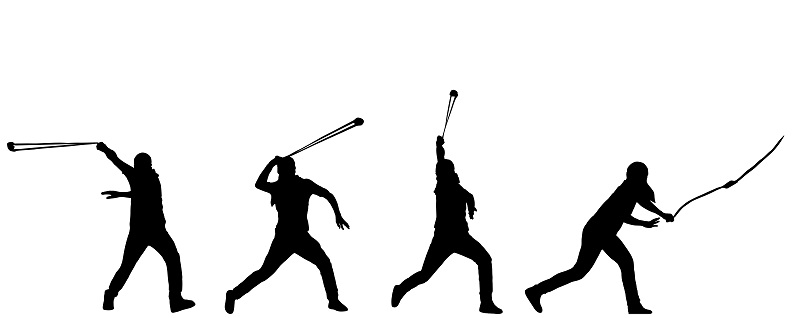
Image:Rehab Nazzal, Resistance Dance, life-size prints on vinyl, 2017
McIntosh Gallery at Western University is pleased to present a PhD. thesis exhibition by activist artist Rehab Nazzal. The show is based on Nazzal’s year-long field research in the occupied West Bank and features an array of works that engage gallery-goers through sight, hearing and smell. In this multi-media exhibition, social commentary and critique intersect with expressive response to the severe realities in the conflict zone, and offers a space where critical inquiry as well as reflection may take place.
Nazzal is a Palestinian-born artist whose works have been widely shown throughout Canada and internationally. “As an artist whose life is shaped by the violence of Israel’s military occupation, it’s my responsibility to provide an alternative representative record of the daily struggles of the Palestinians. I am hoping this show will fill a void in contemporary art and address visually and sonically the Palestinians’ experiences of resisting colonial violence,” she said.
The exhibition, entitled Choreographies of Resistance, includes photographs, video, and sound works that focus on the Palestinian struggle against settler-colonialism in one of the world’s most volatile hotspots, Nazzal notes. It includes a video installation seen through the “eyes” of a gas-mask, and an installation in which photographic images are projected onto hundreds of handmade slingshots as it pays tribute to Palestinians who have lost their lives in what the artist notes is an " intifada, or uprising."
“This will be an immersive journey for visitors, as these works will transmit Palestinian civilians’ experiences from the streets of the occupied West Bank to the gallery space of London, Ontario,” she said.
Much of the work on display was recently presented at AxeNeo7 Gallery in Hull, QC, and at the time Nazzal was invited to lecture at both Carleton University’s Human Rights Department, and at the University of Ottawa’s Visual Arts Department.
Biography
Rehab Nazzal is a Palestinian-born multidisciplinary artist and doctoral candidate at Western University. Her work deals with representations of colonial violence and critically questions the absence of the embodied experience of the oppressed and colonized populations and their resistance within contemporary art practices. Nazzal’s video, photography and sound works have been shown in Canada and internationally, in both group and solo exhibitions, including Prefix Institute of Contemporary Art, Toronto; Karsh-Masson Art Gallery, Ottawa; Khalil Sakakini Center, Ramallah; Art Gallery of Mississauga; and the San Francisco Museum of Modern Art. Nazzal holds an MFA from Ryerson University in Toronto, and a BFA from the University of Ottawa. She has received awards and scholarships from Western University, Ryerson University, and the University of Ottawa, as well as grants from the Canada Council for the Arts, the Ontario Arts Council, and the City of Ottawa. She also is a recipient of the Social Sciences and Humanities Research Council of Canada doctoral award.
For more information contact Mitra Shreeram, Communications and Outreach Coordinator at mshreera@uwo.ca or 519.661.2111 ext. 87576
Surveillance Signal
Philip Baljeu & Francisco-Fernando Granados
July 6 to 16, 2017 at Satellite Project Space
Opening Reception: July 6 from 7-9 PM
Chuck Blazevic DJ Set: July 6 from 9-11 PM
"Reclaiming Your Digital Privacy: An Interactive Workshop" July 11 from 7-9 PM
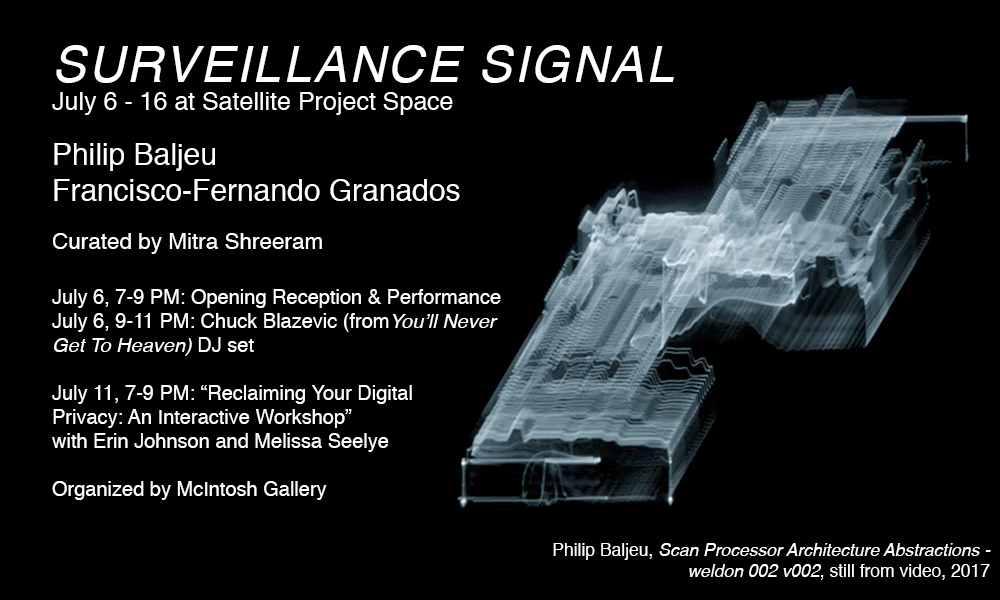
As the internet encroaches on our personal lives, users increasingly end up paying for its services with their privacy. Take for example the unique digital signature you leave when you post something on social media: your geographic location, hardware, operating system, etc. The digital trail we leave behind is a significant identifier of who we are in contrast to our physical and mental presence in the real world. Digital identity is now used to surveil users (with varying levels of consent) by parties ranging from the relatively innocuous to the malicious. Working with these ideas, curator Mitra Shreeram chose Toronto artists Philip Baljeu and Francisco-Fernando Granados to translate these complex surveillance systems into digital video works and a performance.
Granados’s performance spatial profiling… removes the subjective and narrative component of identity and leaves behind only objective data points. The performer’s facial profile is traced repeatedly on a wall until a visual semblance of a waveform is produced, and like a waveform, it denotes a signal (biometric data) at a specific time (the performance). The context required to empathize with the signal source/maker is removed but their signal will remain on the wall underneath the many layers of white paint that will come after the exhibition closes. This new iteration of the work will be performed by Taylor Doyle, Tyler Durbano, and Angie Quick.
“invasive technologies designed to fix migrant identities and to reduce them, in Giorgio Agamben’s memorable phrase, to ‘bod[ies] without words’ (Agamben 2004).”
- Carrie Dawson. The Refugee’s Body of Knowledge: Storytelling and Silence in the work of Francisco-Fernando Granados, TOPIA, Number 29, Spring 2013
Philip Baljeu takes technologies and systems originally intended for signal analysis and repurposes them into unique electronic instruments. In his series Scan Processing Architecture Abstractions, Philip has chosen four buildings in London to surveil: Bell Canada Building, London Courthouse, Western University’s Social Science Centre, and Western University’s D.B. Weldon Library. Each video is first de-saturated of all colour information, fed into a video synthesizer for further manipulation, and the output is displayed on an oscilloscope. This series subverts common surveillance practice by surveilling the structures themselves that either house or make surveillance available. A new sound signal is created as a by-product of this process which is an aural representation of the video. This phenomenon results in a sound bath that resonates near 60hz (the frame rate of the video) and provides different experiences depending on where the listener is in the room.
The underlying system that modern surveillance relies on is signal analysis. From intercepting private communications via backdoors placed in our phones to analyzing biometrics data of refugees, governments and private organizations input these signals into their own proprietary “black box” of signal analysis. The resulting output can be a refugee’s failed asylum application or ever deepening algorithmic profiling. The black box is constructed to be objective to a fault and to ingest the unimaginable amount of data we all produce. Shoshana Magnet observes that those who create these biometric technologies believe that “the human body can be made to speak the truth of its identity through the use of biometrics”
This site specific exhibition takes is organized by McIntosh Gallery and will be held at the Satellite Project Space at 121 Dundas Street, London, ON. The gallery acknowledges funding from the Ontario Arts Council and the Canada Council for the Arts for making this exhibition possible.
For more information contact Mitra Shreeram, Communications and Outreach Coordinator, mshreera@uwo.ca, 519.661.2111 ext. 87576
Artist Bios
Philip Baljeu
Phil Baljeu is a self taught video artist living in Toronto, Canada using self-designed and built electronic instruments to generate audio/visual compositions. Baljeu’s focus is on abstract imagery and textures, often using traditional imagery such as portraits and architecture and manipulating them into alien video sculptures and light paintings.
Baljeu’s work has been shown in the Judith & Norman ALIX Art Gallery, on the Drake Hotel video playlist, The South Kiosk gallery, A/V performances, the VR video game Technolust, and music videos for Zed’s Dead, River Tiber, and others.
Francisco-Fernando Granados
Francisco-Fernando Granados is a Toronto-based artist. His multidisciplinary critical practice spans performance, installation, cultural theory, digital media, public art, and community-based projects. He has presented work in galleries, museums, theatres, artist-run centres and non-traditional sites since 2005. These venues include the Art Gallery of Ontario, Mercer Union, Doris McCarthy Gallery, Blackwood Gallery, Gallery TPW, Trinity Square Video, Images Festival, NuitBlanche, Sur Gallery (Toronto), Vancouver Art Gallery, VIVO Media Arts Centre (Vancouver), Darling Foundry, MAI – Montreal arts interculturels, Fofa Gallery (Montreal), University of Western Ontario (London), Neutral Ground (Regina), Hessel Museum of Art (NY), Defibrillator Gallery (Chicago), Voices Breaking Boundaries (Houston) Ex Teresa Arte Actual (Mexico City), Kulturhuset (Stockholm), and Theatre Academy at the University of the Arts (Helsinki).
August 10 - September 9: Samantha Noseworthy: Midheaven & Quinn Smallboy: Playing A String Game
Samantha Noseworthy
Midheaven
August 10 to September 9, 2017
Closing Reception: September 8, 5-7 PM
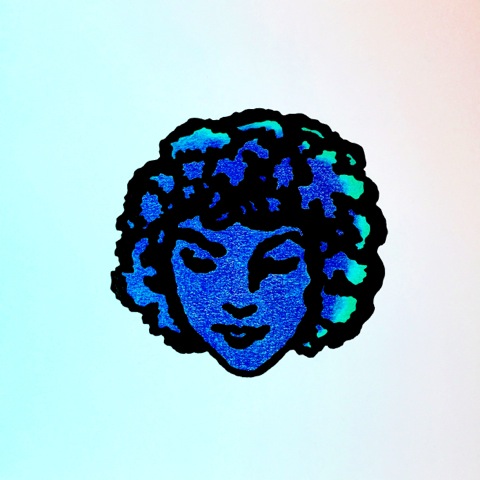

Image: Samantha Noseworthy, Baby Blue, 7 x 7 inches, Ink and Pencil Crayon on Paper, 2017
Midheaven names the tenth house in the natal astrological system. Evoking images of eclipse within in-between realms, it is a point of definition in one’s chart which determines vocation and purpose. Midheaven asks: of what significance is the continuity between contemporary artistic practice and paranormal occurrence?
Drawing upon wildly subjective personal accounts, Samantha Noseworthy’s work and accompanying writings mirror her studies in visual art, poetry and the occult while travelling Atlantic Canada. She utilizes a multimedia approach that combines drawing, iphone photography, found object sculpture, and video.
Samantha received her HBA in Visual Studies at the University of Toronto in 2015, and is currently an MFA candidate at the University of Western Ontario in London, Ontario.
For more information contact Mitra Shreeram, Communications and Outreach Coordinator at mshreera@uwo.ca or 519.661.2111 ext. 87576
Quinn Smallboy
Playing a String Game
August 10 - September 9, 2017
Closing Reception: September 8, 5-7 PM
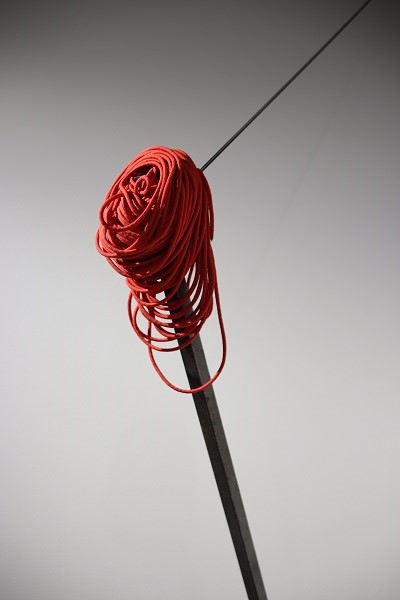
Image: Quinn Smallboy, Nest, string and metal, 9’ x 5” x 5”, 2017
"My work explores symbolic images referring to Indigenous cultures. Through shapes and forms that make up the iconic symbols that surround and are within Indigenous cultures, I approach art making from the standpoint of reshaping alternate interpretations. I am interested in translating Indigenous symbols into works of art, whether through painting or sculpture.
A central material in my sculptural practice is string. I sometimes use solely black string. In other works, coloured string is used, acting as an index to culture and identity.
As an artist, my aim is to draw attention to the struggles surrounding Indigenous culture and art. "
-Quinn Smallboy
Quinn Smallboy is originally from Moose Factory, Ontario, and member of the Moose Cree First Nation. He is an MFA candidate in Visual Arts at Western University who lives in London, Ontario where he focuses his artistic practice.
For more information contact Mitra Shreeram, Communications and Outreach Coordinator at mshreera@uwo.ca or 519.661.2111 ext. 87576
September 22 - October 28: FUTURISMS
FUTURISMS
September 22 - October 28, 2017
Jay Isaac, Luis Jacob, Olia Mishchenko, Pirbhai + Turner, and Young & Giroux
Curated by Adam Lauder
Opening Reception: Friday, September 22, 7-9 PM
Curator-Led Tour Saturday, September 30, 12 PM
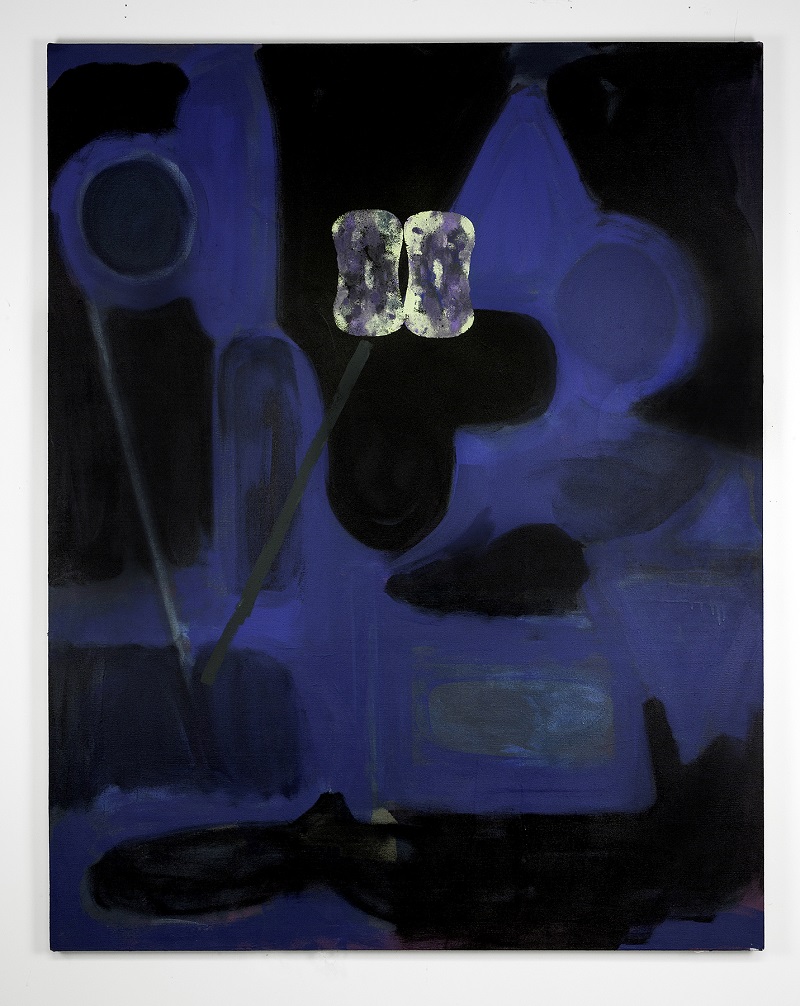
Jay Isaac, Untitled - from the series The Sponges, 2014, acrylic and chalk on canvas, 60” x 48"
Curated by Adam Lauder, Futurisms sets out to both recover and challenge the avant-garde's potential to engage and transform the social. Luis Jacob, Jay Isaac, Olia Mishchenko, Turner & Pirbhai, and Young & Giroux rewrite familiar histories of the future by offering critical perspectives on the recent and distant past while weaving futural fictions. The exhibition revisits the mixed legacies of historical futurist movements as a framework for situating metamodernist inquiry within Canada’s highly conflicted histories of techno-nationalism, colonialism, and slavery. A forthcoming catalogue will plot these concerns within a trajectory emanating from the visionary speculations of the London, Ontario-based radical psychiatrist R.M. Bucke.
For more information contact Mitra Shreeram, Communications and Outreach Coordinator at mshreera@uwo.ca or 519.661.2111 ext. 87576
November 10, 2017 - January 13, 2018: Silence, Pressure, Noise
Silence, Pressure, Noise
Christine Sun Kim, Darrin Martin, Christof Migone, Rehab Nazzal
Curated by Vicky Moufawad-Paul
November 10, 2017 - January 13, 2018
Opening Reception: Friday November 10, 7-9 pm
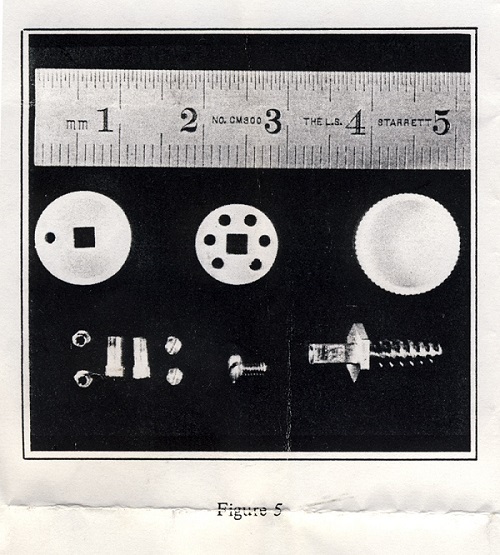
Image: Darrin Martin, Listening In..., 2017, multi-channel installation (detail), image courtesy of the artist.
Silence, Pressure, Noise features the work of Christine Sun Kim, Darrin Martin, Christof Migone, and Rehab Nazzal. "I have assembled this four-person exhibition about the subjectivity of sound and the quandary of its translations to bring to the fore the ways that each of us carry a particular personal history, as well as hearing experience to the exploration and translation of sound. While traversing the boundaries of the materiality of sound, the works of Kim, Martin, Migone and Nazzal connect the aural to the textual and sculptural as well as to meanings and memories," explains curator Vicky Moufawad-Paul. The curator would like to thank the Ontario Arts Council and the McIntosh Gallery for their generous support of this project.
Biographies
Christine Sun Kim is a Berlin-based artist who uses the medium of sound to investigate her relationship with spoken languages and her aural environment. Kim has exhibited and performed in worldwide venues such as Sound Live Tokyo, Tokyo; LEAP, Berlin; Carroll / Fletcher, London; nyMusikk, Oslo; Southern Exposure, San Francisco; Recess Activities, New York; Calder Foundation, New York; the Museum of Modern Art; and MoMA PS1, New York. She has collaborated on sound projects with artists such as Devonté Hynes, Thomas Benno Mader, Wolfgang Müller and Alison O'Daniel, and has held residencies at the Whitney Museum, Haverford College, and Southern Exposure, along with Fellowships at TED and MIT Media Lab.
Christof Migone is an artist, curator and writer. He has performed and exhibited internationally. He co-edited Writing Aloud: The Sonics of Language (2001) and Volumes (2015); his writings have been published in Aural Cultures, S:ON, Experimental Sound & Radio, Radio Rethink, Semiotext(e), Performance Research, etc. He obtained an MFA from NSCAD in 1996 and a PhD from the Department of Performance Studies at the Tisch School of the Arts of NYU in 2007. A book compiling his writings on sound art, Sonic Somatic: Performances of the Unsound Body was published in 2012. He lives in Toronto and is an Assistant Professor in the Department of Visual Arts at Western University in London, Ontario.
Darrin Martin is an interdisciplinary artist whose works engage the synesthetic qualities of perception. His videos have screened internationally at festivals and museums, including the Museum of Modern Art (NY); Pacific Film Archive (CA), Impakt Festival (Netherlands), and European Media Art Festival (Germany). His installations have exhibited at venues including The Kitchen (NY), University of Toronto (Canada), and Grand Central Art Center (CA). He has held artist residencies at Cite Internationale des Arts, Eyebeam, Experimental Television Center, and Signal Culture. Martin also occasionally curates video screenings and teaches in the Department of Art and Art History at University of California, Davis. Born in Catskill, NY, he currently resides in San Francisco.
Rehab Nazzal is a Palestinian-born multidisciplinary artist based in Canada and Palestine. Her video, photography and sound works deal with violations of human rights and the violence of war and colonialism. Nazzal’s work has been shown in Canada and internationally in both group and solo exhibitions, including Prefix Institute of Contemporary Art and A Space Gallery, Toronto; Karsh-Masson Art Gallery, Ottawa; McIntosh Art Gallery; Khalil Sakakini Center, Ramallah; Art Gallery of Mississauga; the San Francisco Museum of Modern Art, and Spanish Institute of Art. Nazzal is currently a PhD candidate at Western University in London, Ontario. She holds an MFA from Ryerson University in Toronto, a BFA from the University of Ottawa, and a BA in Economics from Damascus University in Syria. She is a recipient of the Social Sciences and Humanities Research Council of Canada doctoral award.
Vicky Moufawad-Paul is a Toronto-based curator and writer and she is the Director/Curator at A Space Gallery. Her primary research interest has been the conundrum of representing violence and she has focused her curatorial work on artists that flee from the traps of representation and trouble epistemic certainty. Vicky has curated exhibitions at the Agnes Etherington Art Centre, Carlton University Art Gallery, Gallery 101, Museum London, CONTACT Photography Festival, InterAccess Electronic Media Arts Centre, A Space Gallery, and Prefix Institute of Contemporary Art in Ontario; MAI: Montréal arts interculturels in Quebec; Latitude 53 in Alberta; and 16 Beaver in New York. She has published texts on several artists including Harun Farocki, James Luna, Emily Jacir, Wafaa Bilal, Deirdre Logue, Mohammed Mohsen, Jacqueline Hoang Nguyen, Juan Ortiz-Apuy, Erica Lord, John Halak, Rehab Nazzal, Adam Broomberg, Oliver Chanarin, Akram Zaatari, and Yto Barrada.
For more information contact Mitra Shreeram, Communications and Outreach Coordinator at mshreera@uwo.ca or 519.661.2111 ext. 87576
Contemporary art, visual culture, and art history have long played an important role in facilitating constructive social, political, and diverse cultural conversations.
As such, McIntosh Gallery stands by its responsibility to support the artistic freedom of all exhibiting artists by providing a safe and respectful space for them to express themselves and showcase their work and research. The works in these exhibition express the views of their creators and do not reflect the position of McIntosh Gallery or Western University.






